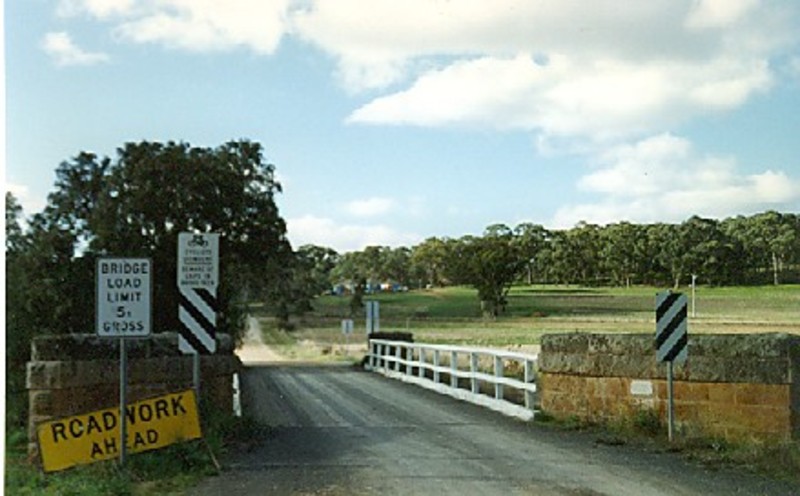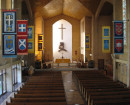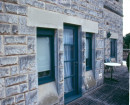Back to search results
Zeal Bridge
Colles Road,, CASTLEMAINE VIC 3450 - Property No B6850
Zeal Bridge
Colles Road,, CASTLEMAINE VIC 3450 - Property No B6850
All information on this page is maintained by National Trust.
Click below for their website and contact details.
National Trust
-
Add to tour
You must log in to do that.
-
Share
-
Shortlist place
You must log in to do that.
- Download report

B6850 Zeal Bridge

On this page:
Statement of Significance
Zeal Bridge is historically, socially and aesthetically significant at State level.
It is the last surviving example of a series of stone-iron-timber bridges built largely from local sandstone after the devastating Castlemaine floods of 1889 demolished many timber bridges. That use of stone-masonry in conjunction with wrought-iron girders represented a continuation of British traditions of bridge building in the colony of Victoria, where British capital had largely financed the gold-mining industry. The British industrial revolution had permitted such adaptations to an earlier tradition of stone or brick masonry arches.
Originally one of a series of similar bridges constructed at Castlemaine with the aid of State flood-relief grants in 1889-90, Zeal Bridge alone of this series today retains its substantial timber top and its original integrity. It is the best example of this type of masonry, wrought-iron and timber bridge to survive in Victoria.
The earliest name for Zeal Bridge, taken from that of a previous all-timber bridge at the same site, was Pennyweight Bridge. The site was associated with Pennyweight Flat and its historic cemetery. Before being officially opened it was named after the prominent State politician, William Zeal, who represented Castlemeine in the Legislative Assembly for many years. Zeal had been an early engineer of the Victorian Railways, and later supervised construction of the Melbourne-Sandhurst railway for contractors Cornish and Bruce. Zeal always strongly opposed the use of timber designs for permanent railway bridges, and this composite masonry, iron and timber structure matches his traditionalist "British" ideas on bridge building.
In social terms, these powerful local associations make the old bridge of continuing special value to residents of Castlemaine and district. Its associations with Pennyweight Flat Cemetery enhance that social value, and make the old bridge a significant component of an important Victorian goldfields tourist attraction.
Aesthetically, the fine ashlar masonry of sandstone with granite facings of Zeal Bridge's substantial masonry substructure, combine nicely with its timber deck and side-rails, and its impressive rivetted wrought-iron girders. Whereas many stone-masonry substructures have been unsympathetically modified in concrete, this bridge remains a visually-attractive entity. The bridge is situated in attractive open surrounding on the edge of a large provincial town.
Classified: 06/11/1998
It is the last surviving example of a series of stone-iron-timber bridges built largely from local sandstone after the devastating Castlemaine floods of 1889 demolished many timber bridges. That use of stone-masonry in conjunction with wrought-iron girders represented a continuation of British traditions of bridge building in the colony of Victoria, where British capital had largely financed the gold-mining industry. The British industrial revolution had permitted such adaptations to an earlier tradition of stone or brick masonry arches.
Originally one of a series of similar bridges constructed at Castlemaine with the aid of State flood-relief grants in 1889-90, Zeal Bridge alone of this series today retains its substantial timber top and its original integrity. It is the best example of this type of masonry, wrought-iron and timber bridge to survive in Victoria.
The earliest name for Zeal Bridge, taken from that of a previous all-timber bridge at the same site, was Pennyweight Bridge. The site was associated with Pennyweight Flat and its historic cemetery. Before being officially opened it was named after the prominent State politician, William Zeal, who represented Castlemeine in the Legislative Assembly for many years. Zeal had been an early engineer of the Victorian Railways, and later supervised construction of the Melbourne-Sandhurst railway for contractors Cornish and Bruce. Zeal always strongly opposed the use of timber designs for permanent railway bridges, and this composite masonry, iron and timber structure matches his traditionalist "British" ideas on bridge building.
In social terms, these powerful local associations make the old bridge of continuing special value to residents of Castlemaine and district. Its associations with Pennyweight Flat Cemetery enhance that social value, and make the old bridge a significant component of an important Victorian goldfields tourist attraction.
Aesthetically, the fine ashlar masonry of sandstone with granite facings of Zeal Bridge's substantial masonry substructure, combine nicely with its timber deck and side-rails, and its impressive rivetted wrought-iron girders. Whereas many stone-masonry substructures have been unsympathetically modified in concrete, this bridge remains a visually-attractive entity. The bridge is situated in attractive open surrounding on the edge of a large provincial town.
Classified: 06/11/1998
Show more
Show less
-
-
-
-
FOREST CREEK TOURIST GOLD MINE
 Victorian Heritage Register H1322
Victorian Heritage Register H1322 -
PENNYWEIGHT FLAT CEMETERY
 Victorian Heritage Register H1675
Victorian Heritage Register H1675 -
PENNYWEIGHT FLAT CEMETERY
 Victorian Heritage Inventory
Victorian Heritage Inventory
-
-








